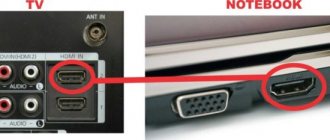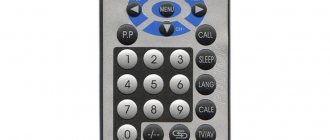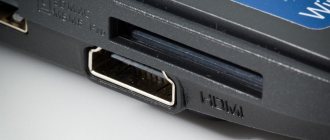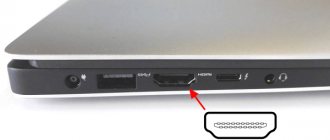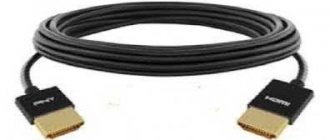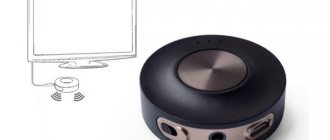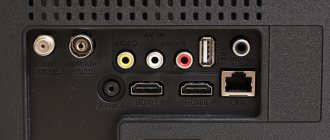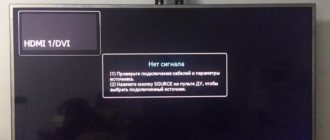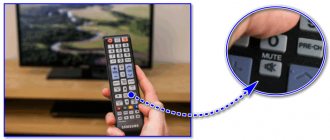Is it possible to connect a laptop to a TV? What a stupid question? Of course you can. Moreover, you don’t even need an HDMI or VGA cable for this. If your TV has support for Smart TV, then you can send a picture to it without any wires using a wifi connection! In a word, let's find out exactly what methods of connecting a laptop to a TV exist, and which of them are the most convenient. Moreover, these methods are universal for any model of Samsung, LG, Sony and other TV manufacturers.
Please note that you can now display the image on absolutely any LCD TV. Even the cheapest model will have an HDMI connector, which is available on all laptops (the only exceptions are old netbooks, which were tiny in size).
If the TV has support for Smart TV, then other types of connections become available. In particular, you can organize a media center on your laptop by sending video to your TV using DLNA technology. In this case, you can use, as mentioned above, the wireless method - it is not necessary to look for a network cable by inserting its ends into the LAN connectors.
Why connect a laptop to a TV?
Connecting a laptop to a TV provides the following options for the user:
- Transferring images from a laptop display to a TV. Televisions, as a rule, have a huge diagonal. Watching videos or playing games in this case is much more convenient.
- Transferring data from the hard drive to the TV memory. Relevant for TVs based on Android, which have their own built-in drive for storing content. The TV can be completely configured as a “node” of the local network. In this case, you can stream content from a laptop even without saving the file in the TV memory (specialized network data transfer protocols, such as DLNA, are used for this).
- TV remote control. Some manufacturers support sending commands via WiFi or Bluetooth. A useful option for those cases when the included remote control is lost or faulty.
- Providing access to the Internet. For example, if you only have a wired router at home, but your TV requires a WiFi connection to access additional features or update software. That is, in this case the laptop is used as a portable access point.
Scart or RCA
This type of connection is intended for old CRT TVs that only have inputs for RCA-Tulips or Scart. You are unlikely to find these connectors on laptops, so you need to use adapters. Scart-VGA RCA-VGA The cost of these adapters is not high.
- We connect the cable, if you use an adapter, then first connect the cord to it.
- We turn on the AV mode on the TV; this is a video channel on old TVs.
- Adjusting the screen resolution on the laptop.
If you use these adapters, then in most cases they already have a built-in audio cable, so the sound will come from the TV itself. However, this method has one drawback: image quality, because using the cable data it is impossible to achieve an ideal image, but this is enough for many.
Connection via cable
There are the following options for connecting TV and laptop via cable:
- via HDMI;
- via DVI;
- via Scart;
- via S-Video;
- via RCA;
- via VGA;
- via USB;
- via LAN (RJ-45).
Via HDMI
Using an HDMI cable, you can transfer sound and video to your TV. Also, the TV can be used as an additional monitor to expand the work area, and not just to duplicate the image.
The connection is made as follows:
- Turn off your laptop and TV.
- Connect the laptop (HDMI Out port) and TV (HDMI In port) with an HDMI cable.
- Turn on the laptop and TV. Use Windows Mobility Center to configure the second screen. This can also be done through “Settings” (section “System”).
One of the main advantages of HDMI is its support for transmitting images with resolutions up to 4K. The port is provided in almost all laptops and TVs after 2015 release. And the cable also transmits sound. There is no need to output it separately via a 3.5mm jack.
Connecting HDMI "hot" (while devices are turned on) can lead to failure of their graphics adapters (GPUs). This is one of the most expensive parts on the motherboard!
Connection via DVI
DVI is a standard for wired digital or analog image transmission (there are 4 variations of DVI ports, they are partially compatible with each other). Sound is not transmitted through a DVI cable!
First you need to make sure that your TV has a DVI port. It was common in laptops from 2005 to 2015 along with VGA. And at Fujitsu-Siemens it is still actively used.
To connect devices you will need:
- Connect DVI to laptop.
- Connect the other end of the DVI cable to the TV.
- In Windows settings, configure the use of the connected display.
If the laptop does not recognize the connected TV, this means that the TV only receives a digital (or analog) signal that is not supported by the device. The situation can only be corrected with the help of a special converter.
DVI supports image transmission in resolutions up to Full HD (as well as 2K in some cases). To output sound, you will also need a connection via AUX (3.5mm jack).
Connection via Scart
Scart is a universal standard for transmitting digital, analogue images, and sound. The connector has 21 contacts, but all of them are not used at the same time. Scart is only found in very old laptops . But it is still ubiquitous on television.
There are also special converters that allow you to connect the HDMI port of a laptop to the Scart port of a TV.
It is not necessary to turn off the power to the equipment before connecting. Once connected, the laptop automatically recognizes the TV as an additional monitor or external speaker system. Configuration is carried out through “Settings” or “Control Panel”.
Connection via S-Video
S-Video is an analog data transmission standard. Mostly found on older TVs that do not support digital imaging. The resolution limit is 720 by 576 pixels (4 by 3 aspect ratio). The S-Video port can be found on laptops produced before 2010. Sound is connected separately.
The main disadvantage of S-Video is not only its low resolution, but also the lack of support for vertical synchronization. That is, image output is always performed at 24 or 29 frames per second. If it does not match the FPS on the laptop, then “tearing” of the image will occur (correctly called “tearing”).
Connection via RCA
Via RCA you can transmit video in a resolution of up to 720 by 576 pixels, as well as stereo sound (analog). Common on both old and modern TVs. In laptops - only up to 2010 release. There are also special converters from HDMI, DVI or VGA to RCA.
RCA is often also referred to as “tulips”. The cable has 3 ports: red, white, yellow. If there is no white or red on a TV or laptop, this means that sound output is only possible in mono mode.
Connection via VGA
VGA is one of the most common analogue image transmission standards. Found in many laptops and PCs. On TVs too.
Supports resolutions up to Full HD, storyboards up to 120 FPS (if the matrix is designed for such a refresh rate). One of the connector pins is responsible for transmitting technical information, so the connection should be recognized by the laptop by default. That is, Windows will determine the hardware model, supported resolutions, and update frequency.
The only caveat: both the laptop and the TV can only use one resolution at a time. To connect, it is not necessary to turn off the power to the equipment.
Via USB
You can connect a TV and a laptop via a USB cable only if the TV supports the OTG standard (you must first check the instructions). Most often, this connection option is used for data transfer (the TV is recognized as a removable storage device), as well as for firmware updates.
Connection via LAN cable
This is possible if the TV has an Rj-45 port (aka LAN, aka Ethernet). Allows you to create a local network between your laptop and TV for data exchange, as well as for Internet access. The exact list of functions that will be available on TV depends on the manufacturer.
How to transfer a picture: settings for Windows 7, 8, 10, XP?
In this case, the simplest connection will be a Wi-Fi connection. Here, each system is ready to operate without nuances. In modern devices, Wi-Fi is built into the system unit. If your TV supports Smart TV, you can connect both devices via the same Wi-Fi network. For a wireless connection, the type of operating system is not important. To connect two devices you need to follow several steps:
- On a personal computer, right-click on the desktop and click on *display options*.
- A display window will open in front of you. Scrolling down, you will see the option * connect to display *.
- Click on the display and a window will open in front of you. After downloading, select the electronic device you need.
In this case, the display will completely switch to the non-native screen. If you want to download the video separately, then this problem has been resolved in Windows 10.
- Launch the *Movies and TV* application.
- Smart TV, after playing the video, you need to click on the ellipsis in the lower right corner and select * transfer to device *.
If you do not have this operating system, you can use the KMPlayer program, which supports a huge number of resolutions and video formats.
Setting up sound after connection
The sound is configured as follows:
- If you are using an HDMI connection, you must first enable the appropriate sound card (HDMI) in the Windows sound settings. Otherwise, audio is output through the built-in speakers.
- If you are using a DVI, VGA, Scart, RCA, S-Video cable connection, then the sound is connected via a separate 3.5mm cable to the AUX connector of the TV. The audio will automatically play on the TV after this as it is recognized as an external speaker.
Types of video output connectors
In order to connect a laptop to a TV, there are different types of connectors that determine the characteristics of the video and audio signals transmitted to the external electronic device, as well as the type of cable used.
HDMI connector
HDMI connectors are designed for connecting a high-quality digital image connecting cable; they come in three sizes: regular, mini and micro (type A, C, D), and five modifications according to the number of contacts:
- Type “A” - 19 contacts.
- Type “B” - 29 contacts.
- Type “C” - 19 contacts (mini).
- Type “D” - 19 contacts (micro).
- Type “E” - 19 contacts.
HDMI cross-sectional view
PCs and televisions of the latest modifications are equipped with one or another standard size of HDMI connectors.
DVI connector
DVI connectors are used to transmit video signals in various expressions, which determines their types:
- Type DVI-D – only for digital signal.
- Type DVI-A – only for analog signal.
- Type DVI-I – can be used to transmit both digital and analog signals.
The design and appearance of connectors of various types are identical, the only difference is in the connection diagram of the contacts inside the interface.
Appearance of DVI connectors of different types
Another difference between this type of connectors is the data transmission mode, there are two of them: single and double.
In single link mode, the maximum possible signal is 165 MHz, and in dual link mode, the limitations depend on the technical capabilities of the connecting cable.
VGA connector
VGA is a connector designed for transmitting an analog signal, equipped with fifteen contacts. It is an obsolete type of contact connection and is gradually being replaced by the types of interfaces discussed above.
VGA Appearance
S-video and SCART connectors
Widely used types of connectors for a long time, especially when it is necessary to quickly connect electronic devices into a single network, provided there is no need for high quality of the transmitted signal.
SCART (Euro connector) is a 21-pin connection installed on older household appliances, as well as modern models, due to its versatility.
The RCA connector, or “tulip” , is also widespread on PCs and household appliances in the budget segment.
SCART and tulip connectors
S-video - this type of connector is used in video cameras, personal computers and game consoles when connecting them to television receivers.
Appearance of the S-video connector
This is an analog interface, available with 4 and 7 contacts, the quality of the transmitted signal is better than the RCA connector (“tulip”).
DisplayPort type connector
DisplayPort is a standard interface for high-speed transmission of digital video and audio signals.
According to the developers, this type of connector should supplant VGA and DVI interfaces.
